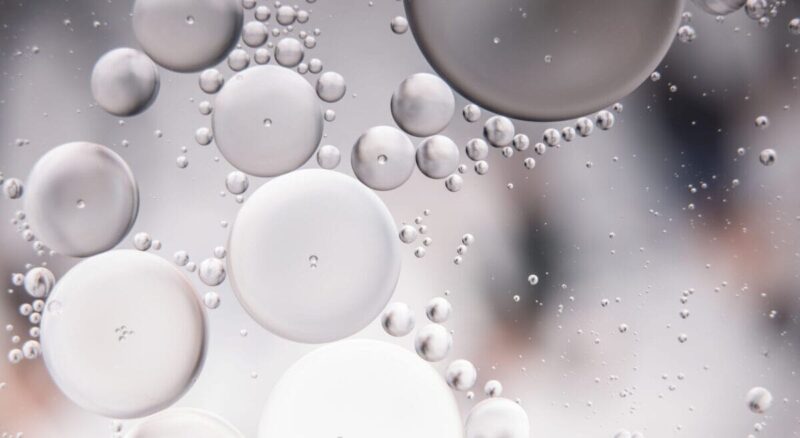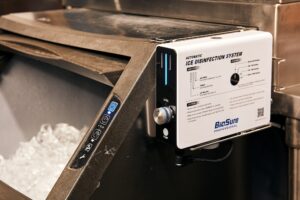Ozone is one of the world’s most powerful oxidizing agents, as it readily removes organic and microorganisms and pollutants in water supplies. Ozone is a molecular compound of three oxygen atoms (O3), in which two oxygen atoms from the basic oxygen molecule (O2 – the oxygen that humans breathe) and contains a third oxygen atom that can easily detach from the ozone compound and reattach to other molecules. When this third oxygen atom, called a radical, attaches to the molecules of other substances, it can break down their structure and destroy them.

How does Ozonation work?
Ozonation is the infusion of ozone with water to both disinfect water and to be used as a disinfection agent for a variety of applications and industries. During ozonation, ozone directly attacks the surface layer of microorganisms and destroys their cell walls, as it is a highly reactive oxidant. When ozone is added to water, it quickly dissolves contaminants without any changes to the composition of water and introduces no odor or taste. The ozonation method is highly effective in killing bacteria, viruses, and other microorganisms that contaminate water and can lead to cancers and other related illnesses. An ozonation system usually consists of a two-stage process; ozone generation and ozone reaction.
BES ozone generators produce ozone through the use of energy using electrolysis technology. Our EOG (Electrolytic Ozone Generator) is safe, as a NOx-free technology. High purity ozone dissolves in water up to 400 percent more effectively and efficiently than other ozone generation methods. The resultant ozone is then dissolved into the water for treatment, where it reacts with unwanted contaminants and neutralizes them.
Why Ozonated Water?
Water is one of the most critical and basic of human needs, yet is one of the most challenging to provide. One of the largest problems facing developed and developing nations alike is access to clean and safe drinking water. Clean, drinkable water is one of the world’s most valuable commodities, and every individual around the globe should have access to it. However, even though greater and greater numbers of countries continue to advance, modernize, and become more technologically advanced, there is not a corresponding increase in the number of people who have access to purified, clean water. The cost of this lack of access to disinfected water is measured not in dollars, but in health and lives. With the UN declaring access to clean water a basic human right, water is the one necessity governments absolutely must invest in.
However, the challenge of providing clean, potable water for the world’s citizens isn’t as straightforward as simply purifying our water sources. When doing so, it is necessary to minimize the amount of Disinfection By-Products (DBPs) used in the process, as well as those present in the final result. Decontaminating water can become a complex process with a myriad of difficulties to overcome, as amongst the impurities found in unsafe water are allergens, bacteria, and viruses – all leading factors in human disease and death.
The use of ozone to disinfect water has been proven to be one of the most efficient methods possible, as it introduces the least amount of DBPs into the environment. Ozone is a powerful oxidizing agent that can be used to decontaminate water quickly and without producing any of the harmful by-products that are so damaging to both humans and our environment.
Benefits of Ozonated Water
Ozonated water is one of the fastest and safest methods for disinfecting water and has numerous benefits for people and the environment. One of the greatest benefits of ozone is how effective it is in disinfecting water; it quickly and thoroughly kills bacteria, viruses, and disease-causing microorganisms. Ozonated water also removes colors, taste, and odor from water, making it safer to drink. Ozonated water can purify water of most pathogens and create safe and clean water for people to drink, to cook with, and to clean with.
Ozonation does not add chemicals to the water (as with chlorination) and can be used regardless of the unprocessed water’s initial pH level. This removes the need for any pH balancers and the associated time, cost, and equipment other methods introduce into the purification process. Perhaps most impressively, the resultant purified water is pH neutral with no extra steps or processing required.
After the water is disinfected, any remaining ozone simply breaks down naturally and doesn’t pollute the air or water – it quickly returns to the atmosphere as regular O2– oxygen that is safe to breathe. Consequently, ozonated water does not produce any harmful by-products, keeping the environment safe and clean, thus reducing overall pollution. On a macroscale, ozonated water can also be used to disinfect polluted waters caused by large industrial businesses. As ozonated water is created by the self-contained ozone generator, it doesn’t require costly and cumbersome storage or transportation.
Developments in Ozone Systems
Traditional methods used to make ozone have been known to have limited downside, including being generally more expensive than a chlorine-based system and requiring qualified professionals for design, operation, and maintenance. However, BES electrolysis ozone generators solve this problem through electrolysis technology that saves money due to lower power consumption, and simplifying the technology so most technicians can quickly install ozone systems that automate the disinfection process, making ozone a more reasonable choice compared to chlorine.
Ozonated Water is Here to Stay
The use of ozone to disinfect and sanitize water is the most beneficial approach when protecting people from unwanted pathogens and microorganisms and promoting overall human health. Ozone is an ideal solution to providing entire communities with clean and drinkable water that is essential to having a productive and vital society. Access to clean water is imperative to human health and safety. On a larger scale, clean water is necessary for agriculture, food production, and sanitation. All of these factors make for a healthier population and support a better quality of life. Contact us to learn more.
Copyright besgroups.com All Rights Reserved
Related Articles
Your Questions on Ozone Water Answered
What is Ozone Water?
Is Ozone Water Safe?
What is the Advantage of Electrolytic Ozone?
Chlorine Solution vs Ozonated Water: The Debate in Professional Sanitation
Ozonated Water vs UV Light Sanitation: Which is the Best Chemical-Free Sanitation?



